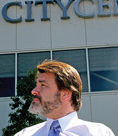
If the individual architects that created the magnificent buildings and edifices at CityCenter are like brilliant musicians, then the conductor of the orchestra is MGM Resorts International Vice President of Design Sven Van Assche. From the conception of CityCenter, through to rough patches mid-construction to the glorious opening ceremonies, Van Assche was the one who held it together, who made sure all the pieces fit.
From the start, when a large project was considered for the site that was once the Boardwalk Casino Hotel and other lots, Van Assche says some traditional uses were considered.
“We had roughly the same acreage that the Bellagio sits on today, and we could not justify the use of that acreage financially for a single-use resort hotel,” says Van Assche. “And we thought a compound of casinos didn’t make a lot of sense because of the oversaturation factor.
“We started looking at what we could do to augment that single casino that would build the revenue we’d need. So we looked at what we’d done well up until that time: restaurants, retail and—at that time—the housing boom. The condominium projects around the Strip were more than just homeownership. So we looked at all of those things and decided that this project could be more than just a casino and create more than just gaming revenue.”
The presentation to the board was the next step. Van Assche says MGM executives Terry Lanni, Jim Murren and Bobby Baldwin were able to convince the board and principal shareholder Kirk Kerkorian to do something different, albeit with a higher price tag.
“We also had to convince them that this was feasible, not only financially, but physically,” he says. “No one had ever put this kind of density on this amount of acreage in Las Vegas before. It’s approaching Manhattan-like density.”
Putting Pieces Together
After master-planning the project throughout 2004 and getting the final approval of the board, it came time to pick the architects. Van Assche says they aimed high.
“There was a lot of testing the waters, discussions and selling the idea at the start,” he says. “I was impressed that these so-called ‘black cape’ architects were so easy to approach. You listen to the talk about their egos, but they were very welcoming. We talked to 25 to 30 of them, and they allowed us to come in and present our admittedly sketchy ideas.”
Most of the architects contacted by MGM had never worked in Las Vegas.
“We told them this is not what they think it is, which is the reason they had never been to Vegas,” says Van Assche. “We had to change that preconceived notion and we had to do it without a picture or a sketch. The first question was often, ‘I don’t do volcanoes so what do you want from me?’ But once we got these guys involved, you realized you could do something really special.”
Blending the individual designs with the others was another challenge, says Van Assche.
“Each experience was unique, but then we had to make sure that they were understanding and mindful of the big picture,” he says. “They had their own building, their own scope, something for which they would produce the venacular, but you had to do so with the understanding of what everyone else was doing that would create the complex that is CityCenter.
“We worked very intimately with every one of the architects and designers to make sure they were doing their scope but understood who was next door, who was across the street and how they all related to each other.”
Command & Control
While arranging the design and construction is always complicated, the economic downturn and subsequent financial struggles of MGM Resorts added yet another difficulty in building such a complex structure. Van Assche says these problems were unexpected, but that they needed to be solved.
“We faced a lot of hurdles on this project in the five years we have been working on it,” he says. “So we had to consider all options, including shutting down, as we worked through them. But the fact that we emerged at the other end is testament to how hard we worked to get here.”
The financial element was out of the control of the designers, architects and all those working on CityCenter, so Van Assche says they just put their heads down and worked.
“That was for someone else to deal with,” he says. “Everybody understood that we just had to get our jobs done. It was a huge effort to instill the morale in everyone here to overcome the doubts and still keep your mind focused on the job at hand.”
In the end, however, Van Assche believes that the vision for CityCenter was transformative and that the final product lives up to the expectations.
“This project is, today, what it was envisioned to be,” he says. “We didn’t do everything perfectly and I never thought we would. But we did most of it very well. It is everything I had hoped it would be. Given all the hurdles and the challenges we imposed on ourselves, we delivered on everything we attempted.”
Van Assche says the company has much more invested in CityCenter than people generally understand.
“We’re not developers in the traditional sense,” he says. “We own, develop and operate and we never go away like most developers do. We are always striving to out-do ourselves and raise the bar at every step. Now that we are open, we are re-evaluating each piece of the property and if anything is broken, we’ll fix it. We’re listening to our customers and our operators and figuring out what we can do better.”





